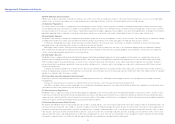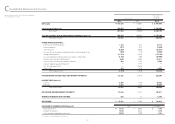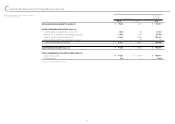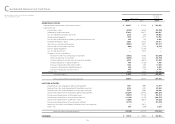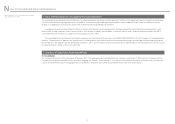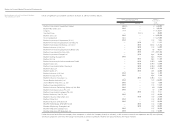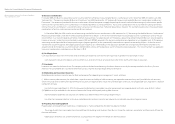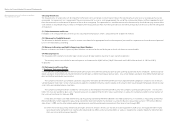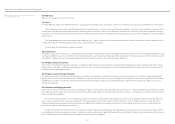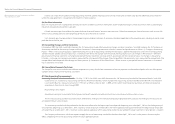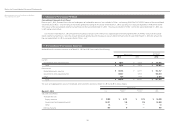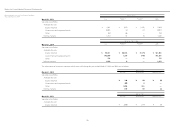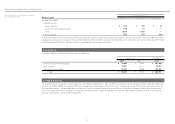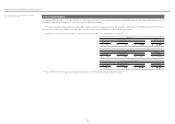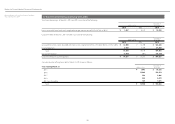Brother International 2014 Annual Report Download - page 30
Download and view the complete annual report
Please find page 30 of the 2014 Brother International annual report below. You can navigate through the pages in the report by either clicking on the pages listed below, or by using the keyword search tool below to find specific information within the annual report.
29
Brother Industries, Ltd. and Consolidated Subsidiaries
Year ended March 31, 2014 The excess of the cost of an acquisition over the fair value of the net assets of the acquired subsidiary at the date of acquisition is being amortized over the estimated
useful life reflecting the pattern of the future economic benefits, unless deemed immaterial and charged to income.
All significant intercompany balances and transactions have been eliminated in consolidation. All material unrealized profit included in assets resulting from transac-
tions within the Group is eliminated.
The fiscal year end of certain foreign consolidated subsidiaries is December 31. These subsidiaries are consolidated using their financial statements as of the parent
fiscal year end, which are prepared solely for consolidation purposes.
(2) Investments in Unconsolidated Subsidiaries and Associated Companies
Investments in five associated companies (five in 2013) are accounted for by the equity method.
Investments in the remaining unconsolidated subsidiaries and associated companies are stated at cost. If these companies had been consolidated or accounted for by
the equity method, the effect on the consolidated financial statements would not have been material.
Accordingly, income from the unconsolidated subsidiaries and associated companies is recognized when the Group receives dividends. Unrealized intercompany
profits, if any, have not been eliminated in the consolidated financial statements.
(3) Unification of Accounting Policies Applied to Foreign Subsidiaries for the Consolidated Financial Statements
In May 2006, the Accounting Standards Board of Japan (the “ASBJ”) issued ASBJ Practical Issues Task Force (PITF) No.18, “Practical Solution on Unification of Accounting
Policies Applied to Foreign Subsidiaries for the Consolidated Financial Statements.” PITF No. 18 prescribes that the accounting policies and procedures applied to a parent
company and its subsidiaries for similar transactions and events under similar circumstances should in principle be unified for the preparation of the consolidated financial
statements. However, financial statements prepared by foreign subsidiaries in accordance with either International Financial Reporting Standards or generally accepted
accounting principles in the United States of America tentatively may be used for the consolidation process, except for the following items that should be adjusted in the
consolidation process so that net income is accounted for in accordance with Japanese GAAP, unless they are not material: (a) amortization of goodwill; (b) scheduled
amortization of actuarial gain or loss of pensions that has been directly recorded in the equity; (c) expensing capitalized development costs of R&D; (d) cancellation of the
fair value model of accounting for property, plant, and equipment and investment properties and incorporation of the cost model of accounting; and (e) exclusion of
minority interests from net income, if contained in net income.
(4) Unification of Accounting Policies Applied to Associated Companies for the Equity Method
In March 2008, the ASBJ issued ASBJ Statement No.16, “Accounting Standard for Equity Method of Accounting for Investments.” The new standard requires adjustments to
be made to conform the associate’s accounting policies for similar transactions and events under similar circumstances to those of the parent company when the associ-
ate’s financial statements are used in applying the equity method unless it is impracticable to determine such adjustments. In addition, financial statements prepared by
foreign associated companies in accordance with either International Financial Reporting Standards or generally accepted accounting principles in the United States of
America tentatively may be used in applying the equity method if the following items are adjusted so that net income is accounted for in accordance with Japanese GAAP,
unless they are not material: (a) amortization of goodwill; (b) scheduled amortization of actuarial gain or loss of pensions that has been directly recorded in the equity; (c)
expensing capitalized development costs of R&D; (d) cancellation of the fair value model of accounting for property, plant, and equipment and investment properties and
incorporation of the cost model of accounting; and (e) exclusion of minority interests from net income, if contained in net income.
Notes to Consolidated Financial Statements


